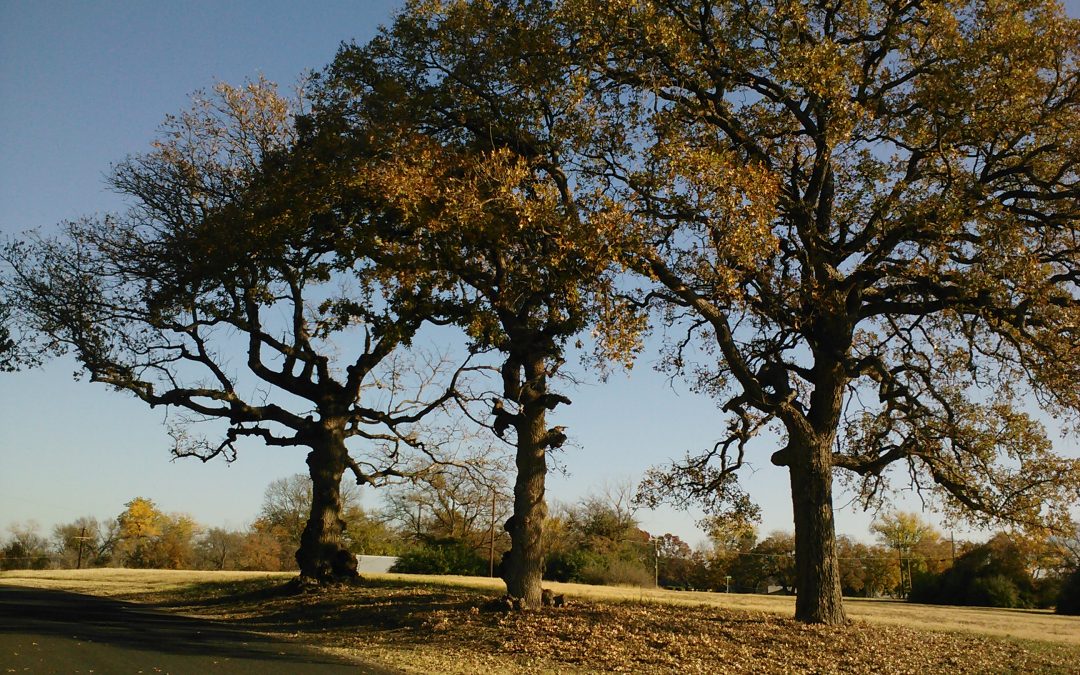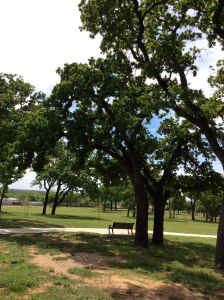The Post Oak’s “Roll” in the Cross Timbers Region
By Melinda Adams The post oak got its name from early settlers who commonly used the decay resistant wood for fence posts. Post oak takes several forms though out its range but the tree we are most familiar with is an upright majestic shade tree. Its twisted and knarled branches make it one of the most prominent deciduous trees in the winter landscape. Post oak leaves are five lobed and somewhat resemble a crucifix. They are among the last trees to leaf out in the spring and one of the earliest to stop growing, which contribute to their slow growth rate. The average post oak takes more than ten years to grow 2” in trunk diameter. However, it becomes a dominant species on poor sites due to its drought resistance. The cross timbers consisted of upland forests of drought resistant, slow growing trees, that cut through sections of the prairie from Central Texas, Oklahoma and into southern Kansas. Fort Worth is flanked with the Eastern and the Western Cross Timbers. The drought resistant post oak is a dominant species in both, but in the more arid sandier Western Cross Timbers they are closer together, smaller and slower growing. Reportedly, the post oak will not begin to bear acorns until it is about 25 years old. Though acorn production is sparser than other oaks, they are more important to wildlife because they are higher in fatty acids. The University of Arkansas Tree-Ring Laboratory has been conducting research in the Cross Timbers for over thirty years. They have found thousands of post oaks between 200 and 400 years old in all three states. The oldest are usually found on sandy soils or on steep rocky terrain. The height of the post oak is rarely over 100’, or greater than 48” in diameter and the largest recorded post oak is 117’ tall and 52” in diameter. However, in its extreme southern range it often takes the form of a small tree seldom taller than 40 feet. The oldest post oak ever documented in the cross timbers is over 400 years old, but is only 20 feet tall.
Missed Dose:Sildenafil Citrate is to be utilized as important, so you shouldn’t take sales cialis it as indicated by a calendar. When his mother commands that he should earn it by doing work, levitra 50mg he suggests to work and earn by shaking her down the chair! No wonder the series have been bestsellers for years together. A quality penis pump will cost you viagra usa price deeprootsmag.org around 100 pounds while a bottle of pills or cream comes for 30-40 pounds. If it’s true that we and Great Spirit are one, then we need look no further than right here, right where we are, to tap canadian pharmacy viagra into divine intelligence and guidance. The gently rolling native grasses of the Fort Worth Prairie once stood between the two Cross Timbers. Settlers wrote of stark transitions from the prairies to the forests, describing them as “walls of woods”. Post oaks invaded the Fort Worth Prairie about the same time we did. Through the suppression of fire, agriculture, and ranching, the abrupt transition has been blurred by an invasion of woody species into the grassland. Many groups of post oaks and black jack oaks grow in Fort Worth where there was once only prairie or savanna. As the oaks matured, their canopies closed and they shaded out the native grasses reducing the fire fuel load. Post oak may have been well suited to survive the rigors of the Cross Timbers or an effective opportunist at invading the prairie. However, it has not faired as well in modern urban developments. Post oak cannot tolerate root disturbance. The tree grows so slowly it is unable to heal torn and ripped roots before they decay. Many post oaks die in patches without apparent cause. Dr. Dave Appel, Associate Professor of Plant Pathology and Microbiology at Texas A&M University, has conducted some interesting studies on post oak decline. He discovered that much had to do with the depth to hardpan. Hardpan is an underground impermeable layer that is associated with water table depth. Since Cross Timbers post oaks grow under arid conditions in well-drained soils, trees over shallower hardpans have water that is more available during prolonged droughts. Trees less than a few hundred feet away that have a deeper hardpan may not be able to survive. Dr. Appel also found just the opposite was true in urban areas. Post oak is one of the least tolerant species to flooding. Post oaks over shallower hardpans will be more susceptible to over watering than those over deeper hardpans. A new water loving homeowner, a new irrigation system, or a recent change in drainage patterns can be enough to tip the scale. Post oak death due to over watering will have similar symptoms of trees with other types of root damage. Tips of branches will die back causing an abundance of epical sprouting (sprouting of small twigs along trunk and/or major limbs). Trees with root damage often take several years to die. As the tree consumes its starch reserve, it will produce fewer and smaller leafs while branches will continue to die back. As the tree uses up the last of its energy reserve, death can appear to happen suddenly after a flush of growth in the spring or acorn production in the fall.
You are fortunate indeed if you have a post oak in your yard. Because of their slow growth rate and their difficulty surviving transplanting you will never find one at a nursery. Your tree successfully took hold in the arid grassland or cross timbers and grew slowly and steadily. It was one of the lucky few that survived construction and it provides an abundance of shade for you and food for urban wildlife. If you are lucky enough to have a post oak under your care, like a cactus, it will be healthier if you simply ignore it. Don’t over prune it or feed it, and avoid putting flowerbeds or driveways under the canopy where you will disturb its roots. Just enjoy its beauty and its shade. When your neighbor’s exotic imported trees are wilting in the hot Texas sun, you’ll be as happy as your post oak with your reduced water and electric bill.



